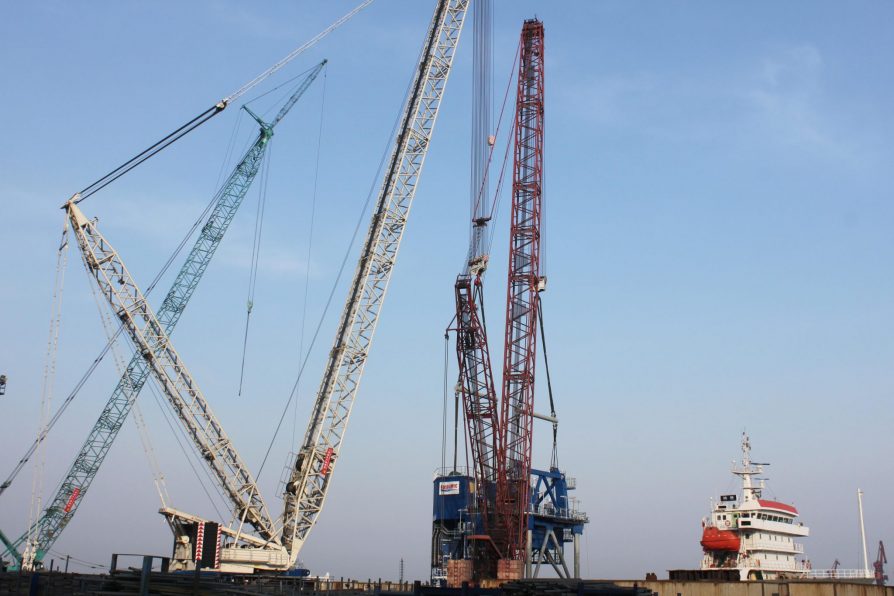)
Penglai Jutal Lifts Ring Gear with Two Terex Crawler Cranes
Engineering service provider Penglai Jutal recently lifted a 330-tonne ring gear for a crane vessel onto a cargo ship on behalf of Cosco Shipyard. In order to complete the project, the company relied on a Terex CC 6800 and a Terex CC 2500-1 crawler cranes for the tandem lift operation.
In terms of weight, a load weighing 330 tonnes is no big deal for a tandem lift with a Terex CC 6800 and a CC 2500-1. Even the load’s dimensions, approximately 15.3 meters by 18.6 meters by 15.6 meters, are not particularly spectacular at first glance. However, once it came to actually lifting the crane vessel’s ring gear, the Penglai team was in for a unique challenge. The load had a center of gravity that was extremely difficult to manage, making it necessary to balance the ring gear with perfect precision in order to perform a safe lift. “This is where the precise and easy-to-use IC-1 touchscreen control system in both cranes proved to be absolutely invaluable, as it enabled us to perform a perfectly synchronized tandem lift,” reports Mr. Chen, the Penglai Jutal director responsible for the project. The Terex cranes’ load moment indicators (LMIs) were also indispensable, as they showed the crane operators exactly how much weight was on their hooks at every moment during the operation.
Complex preparations
In order to safely and efficiently perform the lift, every single obstacle that was not too difficult to move was removed from the wharf so the two Terex crawler cranes would have an ideal area within which to work. The CC 6800 was set up with an SSL configuration, a 90 meter-long main boom, a 40.5 meter-long Superlift mast, a working radius of 24 meters, a superstructure counterweight of 250 tonnes, and a central ballast of 80 tonnes. The CC 2500 was also set up with an SSL configuration but with a 72 meter-long main boom, a 30 meter-long Superlift mast, a superstructure counterweight of 160 tonnes, a central ballast of 40 tonnes, and a working radius of 15 meters. In order to pick up the load safely and with stability, the two crawler cranes worked with spreader beams.
After configuring both Terex cranes, they was in an ideal position to perform the lift. The CC 2500-1 was positioned at a distance of 12 meters in front of the ring gear, while the CC 6800 stood parallel to the CC 2500-1, but offset laterally relative to the load. Once all load-securing devices were placed in to position, the Penglai team performed a test lift to make sure that all the fasteners were in the right place and that the load was perfectly balanced. The ring gear was carefully lifted to a height of about 30 centimeters, and the test lift result was perfect. Once the test lift was done, the team proceeded with the actual lift. The two cranes lifted the load to a height of approximately four meters, and then traveled under load in the direction of the cargo ship. While the CC 6800 stopped and slowly lowered its main boom, the CC 2500-1 kept moving forward until the load was at a working radius of 24 meters relative to the CC 6800. The two cranes then continued traveling forward together until they finally brought the ring gear to the desired position above the ship. According to plan, the cranes lowered the ring gear on to the deck and secured it to the cargo ship to remove all load-securing devices. “All in all, the entire procedure lasted about an hour, and our two Terex cranes completed it with outstanding precision and reliability, just as we expected,” reports director Chen, who was visibly just as happy with the way the lift went as Cosco was.











